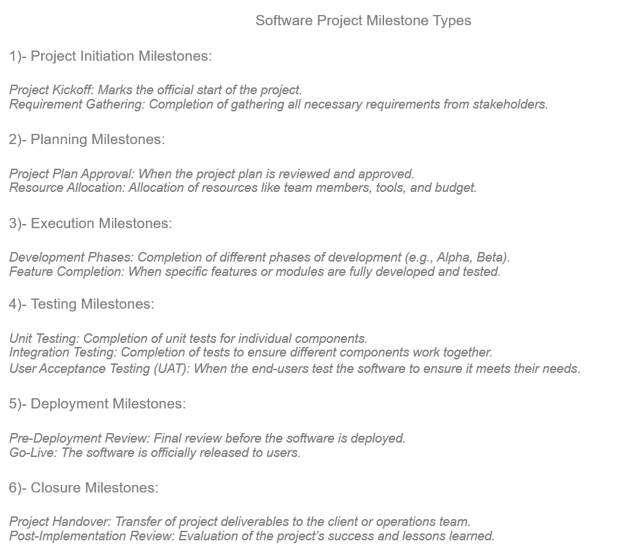
What Are Milestones in Software Projects?
Milestones in software projects are significant points or events in the project timeline that mark the completion of major phases, deliverables, or decision points. They are used to track progress, assess project health, and provide checkpoints for stakeholders to evaluate whether the project is on track. Milestones are not tasks or activities themselves, but rather indicators that a set of related tasks has been completed.
Characteristics of Milestones:
Significant Events: Represent critical points in the project, such as the completion of a key deliverable, the start or end of a phase, or a major decision point.
Non-Duration: Unlike tasks, milestones do not have a duration; they simply mark the completion of an event.
Measurable: Milestones are often tied to specific, measurable outcomes (e.g., “Prototype completed” or “Beta version released”).
Critical for Stakeholder Communication: Serve as communication points with stakeholders to review progress and make decisions.
Common Examples of Milestones in Software Projects:
Project Kickoff: The official start of the project.
Project Requirements Completed: All project requirements have been gathered and approved.
Project Plan & Design Approval: Completion and approval of the software design.
Project Resource Allocation: Allocation of resources like team members, tools, and budget.
Project Development Milestones: Completion of major development phases (e.g., “Module A completed,” “Feature X implemented”).
Testing Phase Start/End: Beginning or completion of the testing phase, including unit testing, integration testing, and user acceptance testing (UAT).
Unit Testing: Completion of unit tests for individual components.
Integration Testing: Completion of tests to ensure different components work together.
User Acceptance Testing (UAT): When the end-users test the software to ensure it meets their needs.
Beta Release: The release of a beta version of the software for external testing or limited customer use.
Go-Live: The official launch of the software.
Project Closure: The formal conclusion of the project, including final documentation and retrospective.
How to Set Milestones in Software Projects
Define Project Scope and Objectives: Start by clearly understanding the project’s goals, deliverables, and overall scope. Milestones should align with these objectives and represent critical achievements necessary to complete the project.
Break Down the Project into Phases: Divide the project into logical phases or stages (e.g., planning, design, development, testing, deployment). Identify key deliverables or outputs for each phase.
Identify Key Deliverables: For each phase, identify the major deliverables that must be completed. These deliverables often serve as natural milestones.
Set Milestones for Critical Decision Points: Identify points in the project where significant decisions must be made (e.g., design approval, go/no-go decision). Set milestones at these decision points.
Consult with Stakeholders: Engage with stakeholders (e.g., project sponsors, team members, clients) to ensure that the milestones reflect their expectations and are aligned with business objectives.
Ensure Milestones Are SMART:
Specific: Clearly define what the milestone represents.
Measurable: Ensure that you can objectively verify when the milestone has been achieved.
Achievable: Set realistic milestones that the team can reach.
Relevant: Milestones should be directly related to the project’s goals.
Time-bound: Assign a target date for each milestone.
Integrate Milestones into the Project Plan: Incorporate the milestones into the project timeline using project management tools like Gantt charts, which visually represent when each milestone is expected to occur.
Communicate Milestones to the Team: Ensure that the project team understands the significance of each milestone and what is required to achieve it.
Monitor and Adjust Milestones as Needed: Regularly track progress against milestones during project reviews. If project conditions change, adjust milestones accordingly to keep the project on track.
Celebrate Milestone Achievements: Recognize and celebrate when milestones are reached. This boosts team morale and provides a sense of accomplishment.
Tools for Tracking Milestones: Gantt Charts: Visualize project timelines and milestones.
Project Management Software: Tools like Jira, Trello, Asana, or Microsoft Project allow you to set, track, and update milestones.
Calendar Integration: Sync milestones with calendar tools to remind the team of upcoming key dates.
Importance of Milestones:
Progress Tracking: Helps in assessing whether the project is on schedule.
Risk Management: Early identification of delays or issues if milestones are not met.
Stakeholder Communication: Provides clear points to report progress to stakeholders.
Team Motivation: Milestones can serve as motivational goals for the project team.
Setting and tracking milestones effectively ensures that a software project remains aligned with its goals and timelines, helping to manage risk and maintain stakeholder confidence.
